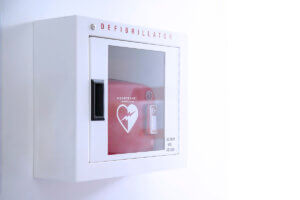11 Jan The Role of AEDs in Reducing Risks of Sudden Cardiac Death

Defibrillators, including the Automatic External Defibrillators (AED), Implantable Cardioverter Defibrillator (ICD), and Wearable Cardioverter Defibrillator (WCD), are devices that can return a person’s heartbeat back to normal by sending an electric current or shock to the heart. They are useful in preventing or correcting an arrhythmia, which is an irregular heartbeat that is uneven, too fast, or too slow that can cause the heart to stop beating in a cardiac arrest or heart attack. If left without intervention, the cardiac arrest can be fatal as the heart stops pumping oxygen-rich blood to the brain which quickly leads to loss of consciousness and eventually sudden cardiac death (SCD).1
Based on the recent Report on Heart Disease and Stroke Statistics by the American Heart Association (AHA), 404,691 people (393,872 adults, 6510 children aged 1-17, and 3,961 infants under 1) arrived in the Emergency Department (ED) with a sudden cardiac arrest in 2016. An average of 82.5% (82.7% in adults, 75.2% in children, and 82.7% in infants) of these individuals did not survive to hospital discharge, which accounts for 333,870 total SCDs (325,732 adults, 4,896 children, and 3,276 infants). By 2018, total mortality from sudden cardiac death increased to 380,000 , including both adults and children (no data breakdown provided for this year).2 We know that early defibrillation improves outcomes for those who experience sudden cardiac arrest. Therefore, it is critical for defibrillators, specifically AEDs, to be made widely available for the public and for people to learn how to operate them for immediate assistance in such critical events.
All types of defibrillators have electrodes, or sensors, that must be connected to the heart either indirectly or directly. These electrodes then send information about the heart rhythm to the central defibrillator computer that further analyzes the rhythm. The computer with built-in algorithms will then decide if the rhythm is normal, or it is an arrhythmia that can be further categorized as a shockable or non-shockable rhythm. Shockable rhythms are described as lethal that can cause a patient’s death unless a shock is delivered by a defibrillator quickly; these include rapid ventricular tachycardia or course ventricular fibrillation. Non-shockable rhythms are those where a shock will not benefit the patient; these include benign or normal rhythms and asystole (no cardiac rhythm). Defibrillators are programmed to send a shock only when a shockable rhythm is observed in the patient with a cardiac arrest in order to maximize benefits and minimize harm.3 For each minute defibrillation is delayed, the odds of survival are reduced by approximately 10%, having access to an AED and knowing how to use one, is critical.( https://www.redcross.org/take-a-class/aed/using-an-aed/what-is-aed)
The three main types of defibrillators available today, the AED, ICD, and WCD, have different applications. The AED is the only defibrillator available to the public for immediate use, particularly in a bystander intervention of a witnessed cardiac arrest. In contrast, the ICD and WCD are only considered by physicians to prescribe to patients with known and sustained, life-threatening ventricular tachycardia or fibrillation. They are designed to monitor heart rhythm 24/7 when attached and will deliver shocks when necessary. The biggest difference between the two defibrillators is that the ICD is placed surgically near the heart and often serves as permanent protection against life-threatening arrhythmias.4 Some ICDs also have a pacemaker function to control abnormal heart rhythms by prompting the heart to beat normally, to speed up a slow rhythm, control a fast rhythm, and help coordinate the different heart chambers.5 The WCD in contrast is commonly prescribed to patients who are pending or do not yet qualify for an ICD and is worn externally with a specially designed vest that is easily removable.6 The ICD and WCD both offer protection to those at the greatest risk of sudden cardiac death; however, only a physician will be able to determine if they are the best safeguards for a patient.
During a witnessed sudden cardiac arrest, the AED is the best option. It is found in public spaces like schools, offices, stores, and airports and are designed for public use. An AED is often located in a noticeable spot (near the front desk) and housed on a wall in a bright red and/or white steel box with a glass window and has a heart-shaped logo with a lightning bolt in the center (like the one shown in the photo). The AED is easily deployable with clear-cut visual and audio instructions that guide the user in defibrillation. It is notable that the AED is not only used in adults, but also in children and infants, as recommended by the American Academy of Pediatrics, American Heart Association, and the American Red Cross.7 There are different-sized electrode pads designed to administer different levels of shock depending on the age and weight of the patient: adult pads accommodate adults and children 8 years and older who weigh > 55 lbs. and pediatric pads used in children and infants under 8 years old and ≤ 55 lbs.
The AED has been shown to significantly increase the chance of survival in those who suffered from an out-of-hospital cardiac arrest (OHCA) among the adult and pediatric populations. In a study, bystanders administered AED shocks to 14.2% of all public adult OHCAs, double the estimate of what was reported years earlier (7.8%).8,9 By narrowing down only to adult OHCAs that are bystander-observed and shockable, those initially shocked by a bystander AED rather than by emergency medical services (EMS) were significantly more likely to survive following a subsequent hospital stay (66.5% vs. 43.0%) and be discharged with favorable functional outcomes (57.1% vs. 32.7%). Additionally, the authors estimated that of the ~350,000 adults who suffer from OHCAs annually, if 100% of the adults with observed and shockable OHCAs were shocked with a bystander AED, approximately 3,459 additional lives can be saved each year.8
In a separate study examining AED use in pediatric OHCAs, it reported similar survival improvement outcomes with bystander AED use and highlighted differences attributing to neighborhood characteristics. Unlike the high bystander AED response rate observed among adult OHCAs, only 10.3% of all pediatric OHCAs had a bystander AED response. The difference in response rate could be attributed to lack of access to public AEDs, limited knowledge about how to use AEDs, misconceptions about AED use in pediatrics, missing pediatric AED pads, and other factors. However, this number fluctuated based on the neighborhood’s demographics and socioeconomic status: AED use was more common in areas with higher median household incomes (>$50,000/year), < 10% unemployment rate, and > 80% high school education. The study also noted greater survival to hospital discharge (35.2% vs. 26.0%) and neurologically favorable survival (31.3% vs. 24.8%) among OHCAs with bystander AED use than without, with slight variability among different neighborhood characteristics.10 By applying the same extrapolation method used by the authors in the adult study, of the ~20,000 pediatric OHCAs annually, if 100% of them with observed and shockable OHCAs were shocked with a bystander AED, around 922 children could be saved annually.8,11
Due to the life-saving potential of AEDs in both an adults and children, it is worthwhile to advocate for more AEDs in the public, particularly in underserved and impoverished areas. In addition to increasing AED availability, it is also necessary for individuals to learn how to utilize AEDs and perform Cardiopulmonary Resuscitation (CPR) on adults and children. In fact, 39 states and Washington D.C. have passed laws or had curriculum changes that require hands-on, guidelines-based CPR training as a prerequisite to graduate high school.12 With the remaining states adopting to implement the similar requirements for high school students, combined with requiring AED training, more lives may be saved.
Additional Resources:
- PulsePoint AED: Locate an AED near you with over 150,000 publicly registered AEDs mapped on the app (available on Apple and Android)
- CPR/AED Training: Get both online and in-person training to perform CPR and AED in both adults and pediatrics through the American Heart Association or the American Red Cross
Written by:
Joyce H. Lee, MS
Medical College of Wisconsin, Class of 2024
Former Research Data Associate at the SUDC Registry and Research Collaborative (2017-2020)
References:
- Defibrillators | NHLBI, NIH. https://www.nhlbi.nih.gov/health-topics/defibrillators. Accessed August 5, 2021.
- Virani SS, Alonso A, Benjamin EJ, et al. Heart Disease and Stroke Statistics—2020 Update: A Report From the American Heart Association. Circulation. 2020;141:E139-E596. doi:10.1161/CIR.0000000000000757
- Kerber RE, Becker LB, Bourland JD, et al. Automatic External Defibrillators for Public Access Defibrillation: Recommendations for Specifying and Reporting Arrhythmia Analysis Algorithm Performance, Incorporating New Waveforms, and Enhancing Safety. Circulation. 1997;95(6):1677-1682. doi:10.1161/01.CIR.95.6.1677
- Implantable Cardioverter Defibrillator (ICD) | American Heart Association. https://www.heart.org/en/health-topics/arrhythmia/prevention--treatment-of-arrhythmia/implantable-cardioverter-defibrillator-icd. Accessed August 5, 2021.
- Pacemakers and Implantable Defibrillators | MedlinePlus. https://medlineplus.gov/pacemakersandimplantabledefibrillators.html. Accessed August 8, 2021.
- Jonathan P. Piccini S, Allen LA, Kudenchuk PJ, Page RL, Patel MR, Turakhia MP. Wearable Cardioverter-Defibrillator Therapy for the Prevention of Sudden Cardiac Death. Circulation. 2016;133(17):1715-1727. doi:10.1161/CIR.0000000000000394
- JW R, WE J, S L, et al. The Use of Automated External Defibrillators in Infants: A Report From the American Red Cross Scientific Advisory Council. Pediatr Emerg Care. 2015;31(7):526-530. doi:10.1097/PEC.0000000000000490
- Pollack RA, Brown SP, Rea T, et al. Impact of Bystander Automated External Defibrillator Use on Survival and Functional Outcomes in Shockable Observed Public Cardiac Arrests. Circulation. 2018;137(20):2104-2113. doi:10.1161/CIRCULATIONAHA.117.030700
- Weisfeldt ML, Sitlani CM, Ornato JP, et al. Survival After Application of Automatic External Defibrillators Before Arrival of the Emergency Medical System. Evaluation in the Resuscitation Outcomes Consortium Population of 21 Million. J Am Coll Cardiol. 2010;55(16):1713-1720. doi:10.1016/J.JACC.2009.11.077
- H G, L W, MY N, et al. Characteristics and outcomes of AED use in pediatric cardiac arrest in public settings: The influence of neighborhood characteristics. Resuscitation. 2020;146:126-131. doi:10.1016/J.RESUSCITATION.2019.09.038
- Topjian AA, Scholefield BR, Pinto NP, et al. P-COSCA (Pediatric Core Outcome Set for Cardiac Arrest) in Children: An Advisory Statement From the International Liaison Committee on Resuscitation. Circulation. 2020;142:E246-E261. doi:10.1161/CIR.0000000000000911
- CPR in Schools Update - You’re the Cure. https://www.yourethecure.org/cpr_in_schools_update. Accessed August 6, 2021.


